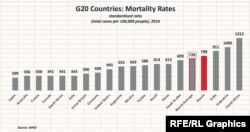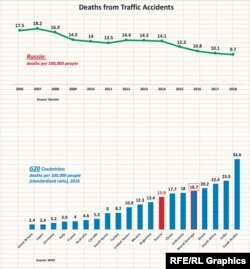According to Russia’s state statistics agency Rosstat, the overall mortality rate in Russia has decreased by almost a quarter since 2005. However, Rosstat does not believe such rates of decrease will continue over the next 15 years. Moreover, the mortality rate is expected to rise again by the mid-2030s.
For international comparisons, so-called “standardized” indicators are used, which take into account the age structure of a country’s populace. Of course, countries where the proportion of “young” generations is higher will have lower simple indicators of total mortality than countries in which the proportion of older people is higher.
We have used these indicators to compare the G20 countries, which together account for more than 80% of global GDP. The most recent estimates for individual countries submitted by the World Health Organization (WHO) are for 2016:
The very structure of mortality in Russia has changed markedly over the past decade. The proportion of diseases of the cardiovascular system (the single largest cause of death), dropped from 57.1 percent of all deaths in 2008 to 46.3 percent in 2018, while the percentage of deaths due to “external causes” (including traffic accidents, murders and suicides, poisoning, etc.), dropped markedly – from 11.8 percent in 2008 to 7.2 percent in 2018.
At the same time, the percentage of neoplasms (the vast majority of them malignant) grew among the causes of death, from 13.9 percent in 2008 to 15.9 percent in 2018, while the percentage deaths from diseases of the nervous system increased nearly nine-fold -- from 0.7 percent of the total in 2008 to 6.2 percent in 2018.
The mortality rate in Russia from all cardiovascular diseases has indeed decreased by 37% the past 13 years, according to Rosstat. Yet, according to the WHO, Russia’s rate of death from cardiovascular disease remains the highest in the G20, and almost twice the world average:
Fatalities from traffic accidents in Russia have decreased significantly over the last 13 years, from a high of 18.2 per 100,000 people in 2007 to 9.7 per 100,000 people in 2018. That is 15 percent lower than the world average but higher than the G20 average:
Mortality from tuberculosis has decreased in Russia by a factor of four since 2005, according to Rosstat, and, according to the WHO, the number of tuberculosis deaths in Russia in 2016 was 2.6 times lower than the world average (6.5 deaths per 100,000 vs. 16.9 deaths per 100,000). Still, Russia had the fourth highest rate of deaths from tuberculosis among the G20 countries, although the three countries with the highest rates – India, South Africa and Indonesia – had rates much higher than Russia’s.
This fact check is translated from our partner, Factograph.info.








